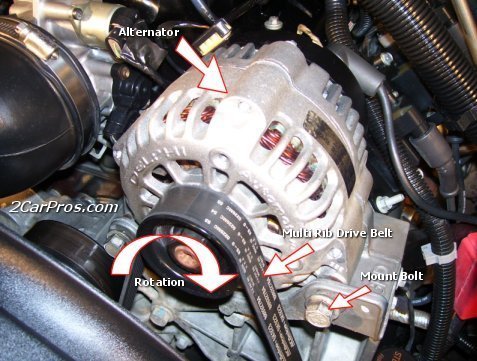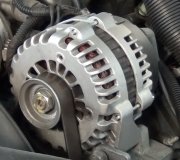First of all, never disconnect the battery while the engine is running. That was a trick done many years ago by mechanics who didn't understand how these simple systems work, but on today's cars it's a real good way to destroy numerous computers in a few seconds. The battery is the key component in helping the voltage regulator maintain a safe system voltage. You have all the information you need with the voltage reading. The battery voltage must be 13.75 to 14.75 volts with the engine running. 12.22 means the charging system is dead and the battery is good but nearly run dead.
Also, the red warning light means the battery is not being recharged while driving, not that the battery is bad. It's telling you there's a charging system problem. Start by measuring the voltages on all of the wires on the generator with the engine running. Holler back with those wire colors and voltages.
Every year I did a demonstration on the alternator test bench for my students to show what can happen when you do that. It was real easy for the voltage to reach over 35 volts. That WILL destroy any computer on the vehicle, the generator's internal diodes and built-in voltage regulator, and any light bulbs that are turned on.
The thinking is that if you disconnect either cable and the engine stays running, the generator must be working but a lot of them will stop working due to the voltage regulator responding to the dips in the "ripple" voltage being produced. That will make a perfectly good generator appear to be bad so that test is not valid.
Some generators respond to the high points in the ripple. That momentary higher voltage goes right back to the field winding and creates a stronger magnetic field. That stronger electromagnet creates a higher output voltage which again creates a stronger electromagnet. It's a vicious circle and voltage can keep on rising until something gives out. The main thing that smooths out that ripple so it doesn't affect the voltage regulator or the generator is the battery.
Three things are needed to generate the output current. They are a magnet, (electromagnet, in this case), a coil of wire, and most importantly, movement between them. That's why the belt needs to make it spin. One thing that can save you from doing damage by removing a battery cable is not raising engine speed. Generators are relatively inefficient at low engine speeds and their output voltage is less likely to rise to dangerous levels, ... As long as you don't raise engine speed.
As to your question about "what about removing the positive cable", it is standard practice to always remove the negative cable first when replacing the battery, and always reconnect it last when putting the battery back in. That's because that cable is connected to the body of the vehicle, so if you accidentally slip with the wrench and it makes contact with the body or battery hold-down bracket and with the battery terminal at the same time, nothing will happen. If you disconnect the positive cable first and the wrench touches the body, the resulting current can weld it to those two points, and it can get so red hot that it melts and bends under its own weight. I've seen it happen twice. Once the negative cable has been removed, accidentally shorting the positive cable to the body won't cause anything to happen because with the negative cable already off, there's no place for current to flow. Besides replacing the battery, one cable needs to be removed when working on or near the generator or the starter. There are a lot of other things that have service manual procedures in which step 1 is "disconnect the negative battery cable". Much of that is for liability but they always state the negative cable is the one to remove so there's less chance of creating sparks.
Speaking strictly on electrical theory, it doesn't matter which cable you remove; either way the battery is removed from the circuit. It's just like the lights in your house. Remove either wire and the bulb turns off.
Ripple is not something that comes up in conversations very often and it's rather hard to explain. You can go here if you care to know more:
but for the average do-it-yourselfer this isn't going to help you fix your van.
One other thing to keep in mind is batteries give off explosive hydrogen gas. Regardless if your generator is working or not there is going to be a big spark when you remove a battery cable with the engine running. Either the generator's current will be recharging the battery, and that can be up to 20 amps, or the battery is going to be supplying the car's electrical systems, and that can easily be over 30 amps. That kind of current is going to create a big spark when a connection is broken or reconnected. Small arc welders run as low as 40 - 60 amps and look at the sparks they create. The reason we don't hear about more battery explosions is because people are careful to not disconnect the cables when there is current flowing through them. It's also why there are huge warning labels on all battery chargers to be sure they are turned off before connecting or disconnecting them from the battery.
Another common generator problem is one defective diode out of the six. You will lose exactly two thirds of the generator's capacity but system voltage will remain normal or it could even be just a little high from the voltage regulator responding to the greatly increased dips in the ripple voltage. The last section on that web page explains excessive ripple.
It's always a good idea to wear safety glasses when working around car batteries, but if you still insist on removing a cable while the engine is running, a face shield makes more sense, and have plenty of water on hand to wash any acid off the vehicle's paint.
Ford used to have a really nice generator design that allowed testing right on the back of the unit. Only Chrysler alternators are easier to diagnose. Unfortunately the engineers don't really care about ease of service and on yours one of the key test terminals is no longer accessible. I have the older systems memorized, and you can get an idea of how they work here:
I suspect the same circuit design is used and two of the smaller wires in the side plug hold the key in diagnosing this system. We should be able to figure this out but I'll try to make one of my miserable Ford service manuals on DVD work if we have to resort to that. Start by measuring the voltage on the large output wire bolted to the back with the engine off. You should find full battery voltage there, approximately 12.6 volts if it's fully charged. One of the small plug-in wires should have 12 volts too, and one of them should have around 2.0 volts if the battery light is on. That one will rise to over 12.0 volts with the engine running and the generator working to turn the dash light off. Again, that's if the circuit is the same as on the early to mid '90s systems. If you take those measurements, list them along with the colors of the wires.
Tuesday, June 12th, 2012 AT 3:05 AM




